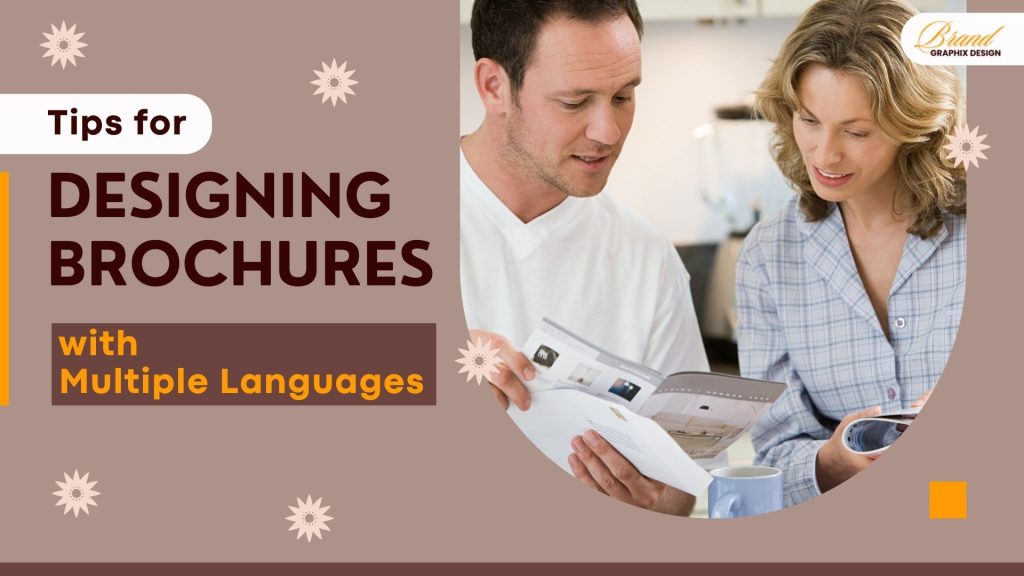Introduction
Designing brochures with multiple languages can be challenging but rewarding. In today’s globalized world, reaching a diverse audience is essential. A well-designed multilingual brochure helps bridge communication gaps and ensures your message is understood by people from different linguistic backgrounds. This blog will provide tips for designing effective multilingual brochures.
Understanding Your Audience
Before starting the design process, it’s crucial to understand your audience. Knowing the languages your audience speaks and their cultural preferences can guide your design decisions.
Here are some tips to understand your audience better:
- Market Research: Conduct research to identify the primary languages spoken by your target audience.
- Cultural Sensitivity: Be aware of cultural differences that might affect the design and content of your brochure.
- Feedback and Surveys: Use surveys and feedback from your audience to understand their preferences and needs.
Choosing the Right Languages
Selecting the right languages for your brochure is vital. Focus on the languages that will have the most significant impact on your audience.
Consider these factors when choosing languages:
- Demographic Data: Use demographic data to identify the most widely spoken languages in your target market.
- Business Goals: Align language choices with your business goals and expansion plans.
- Customer Preferences: Consider the languages preferred by your existing and potential customers.
Translation Accuracy
Accurate translation is crucial for conveying your message correctly. Poor translations can lead to misunderstandings and damage your brand’s reputation.
Follow these tips to ensure accurate translations:
- Professional Translators: Hire professional translators with expertise in the target languages and industry.
- Proofreading: Have translations proofread by native speakers to ensure accuracy and cultural appropriateness.
- Consistent Terminology: Use consistent terminology across all languages to maintain clarity and coherence.
Layout and Design
Designing a brochure with multiple languages requires careful planning of the layout to ensure readability and visual appeal.
Consider these design tips for multilingual brochures:
- Balanced Layout: Create a balanced layout that accommodates all languages without overcrowding.
- Separate Sections: Use separate sections for each language to avoid confusion.
- Font Choices: Choose fonts that support all the required languages and maintain readability.
- Consistent Style: Maintain a consistent design style across all language sections to ensure a cohesive look.
Font Selection
Choosing the right fonts is essential for readability and aesthetic appeal. Different languages have different typographic needs, so selecting fonts that support all the languages is crucial.
Here are some tips for font selection:
- Multilingual Fonts: Use fonts that support multiple languages, including special characters and scripts.
- Readability: Choose fonts that are easy to read, even in smaller sizes.
- Consistency: Maintain consistency in font style across all language sections to ensure a unified design.
Color and Visuals
Colors and visuals play a significant role in the overall design and effectiveness of your brochure. They can enhance readability and appeal to your audience.
Consider these tips for using color and visuals:
- Color Harmony: Choose colors that complement each other and are culturally appropriate for your target audience.
- Visual Hierarchy: Use color to create a visual hierarchy, guiding the reader’s eye to the most important information.
- Images and Icons: Use culturally relevant images and icons to enhance the visual appeal and understanding.
Content Organization
Organizing content in a multilingual brochure requires thoughtful planning to ensure that all information is easily accessible and understandable.
Follow these tips for effective content organization:
- Clear Structure: Create a clear structure with headings, subheadings, and bullet points to break down information.
- Logical Flow: Arrange content in a logical flow that guides the reader through the brochure.
- Consistent Layout: Maintain a consistent layout across all language sections to avoid confusion.
Proofreading and Testing
Proofreading and testing are critical steps to ensure the quality and effectiveness of your multilingual brochure. It helps identify and correct errors before finalizing the design.
Consider these tips for proofreading and testing:
- Multiple Proofreaders: Use multiple proofreaders, including native speakers, to check for errors and inconsistencies.
- Test Readability: Test the brochure with a sample audience to ensure readability and understanding.
- Final Review: Conduct a final review of the brochure to ensure that all content is accurate and visually appealing.
Printing Considerations
Printing a multilingual brochure requires careful consideration to ensure that the final product meets your quality standards.
Follow these printing tips:
- High-Quality Printing: Choose a high-quality printing service to ensure that colors and fonts are accurately reproduced.
- Paper Quality: Select a paper quality that enhances the visual appeal and durability of the brochure.
- Proof Copies: Request proof copies to check for any errors or issues before the final print run.
Digital Versions
In addition to printed brochures, consider creating digital versions that can be easily shared online. Digital brochures can reach a wider audience and provide an interactive experience.
Here are some tips for creating digital brochures:
- Interactive Elements: Include interactive elements such as links, buttons, and videos to engage the audience.
- Mobile-Friendly Design: Ensure that the digital brochure is optimized for mobile devices.
- Easy Sharing: Make it easy for readers to share the digital brochure on social media and other platforms.
Localization
Localization goes beyond translation to adapt content for a specific cultural context. It involves considering cultural nuances, preferences, and behaviors to make the brochure more relevant and appealing to the target audience.
Consider these tips for localization:
- Cultural Relevance: Ensure that the content and visuals are culturally relevant to the target audience.
- Local Preferences: Consider local preferences and behaviors in the design and content of the brochure.
- Feedback from Local Experts: Seek feedback from local experts or native speakers to ensure accuracy and appropriateness.
Case Studies and Examples
Including case studies and examples in your brochure can provide real-world context and demonstrate the effectiveness of your products or services.
Here are some tips for using case studies and examples:
- Relevant Examples: Use examples that are relevant to the target audience and industry.
- Clear Presentation: Present case studies clearly and concisely, highlighting key points and results.
- Visual Support: Use visuals such as images, charts, and graphs to support the case studies and examples.
Designing brochures with multiple languages can be a complex process, but it is essential for reaching a diverse audience effectively. By following these tips, you can create multilingual brochures that are accurate, engaging, and visually appealing. If you need expert help with designing multilingual brochures,
Contact us at +91 911 891 1171.
Click the link to text us on WhatsApp: https://wa.me/918881361111.



